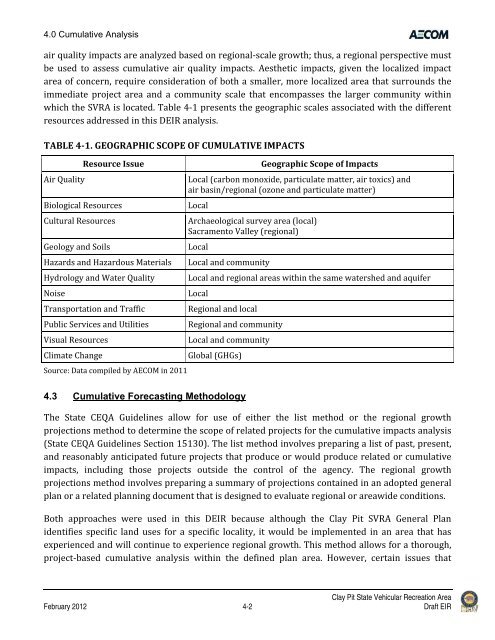Draft Environmental Impact Report - California Off Highway Vehicle ...
Draft Environmental Impact Report - California Off Highway Vehicle ...
Draft Environmental Impact Report - California Off Highway Vehicle ...
You also want an ePaper? Increase the reach of your titles
YUMPU automatically turns print PDFs into web optimized ePapers that Google loves.
4.0 Cumulative Analysis<br />
air quality impacts are analyzed based on regional‐scale growth; thus, a regional perspective must<br />
be used to assess cumulative air quality impacts. Aesthetic impacts, given the localized impact<br />
area of concern, require consideration of both a smaller, more localized area that surrounds the<br />
immediate project area and a community scale that encompasses the larger community within<br />
which the SVRA is located. Table 4‐1 presents the geographic scales associated with the different<br />
resources addressed in this DEIR analysis.<br />
TABLE 41. GEOGRAPHIC SCOPE OF CUMULATIVE IMPACTS<br />
Resource Issue Geographic Scope of <strong>Impact</strong>s<br />
Air Quality Local (carbon monoxide, particulate matter, air toxics) and<br />
air basin/regional (ozone and particulate matter)<br />
Biological Resources Local<br />
Cultural Resources Archaeological survey area (local)<br />
Sacramento Valley (regional)<br />
Geology and Soils Local<br />
Hazards and Hazardous Materials Local and community<br />
Hydrology and Water Quality Local and regional areas within the same watershed and aquifer<br />
Noise Local<br />
Transportation and Traffic Regional and local<br />
Public Services and Utilities Regional and community<br />
Visual Resources Local and community<br />
Climate Change Global (GHGs)<br />
Source: Data compiled by AECOM in 2011<br />
4.3 Cumulative Forecasting Methodology<br />
The State CEQA Guidelines allow for use of either the list method or the regional growth<br />
projections method to determine the scope of related projects for the cumulative impacts analysis<br />
(State CEQA Guidelines Section 15130). The list method involves preparing a list of past, present,<br />
and reasonably anticipated future projects that produce or would produce related or cumulative<br />
impacts, including those projects outside the control of the agency. The regional growth<br />
projections method involves preparing a summary of projections contained in an adopted general<br />
plan or a related planning document that is designed to evaluate regional or areawide conditions.<br />
Both approaches were used in this DEIR because although the Clay Pit SVRA General Plan<br />
identifies specific land uses for a specific locality, it would be implemented in an area that has<br />
experienced and will continue to experience regional growth. This method allows for a thorough,<br />
project‐based cumulative analysis within the defined plan area. However, certain issues that<br />
Clay Pit State Vehicular Recreation Area<br />
February 2012 4-2 <strong>Draft</strong> EIR








